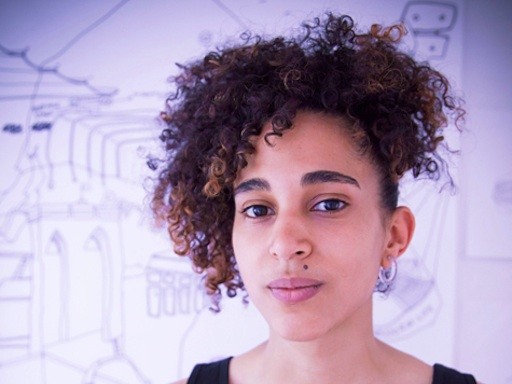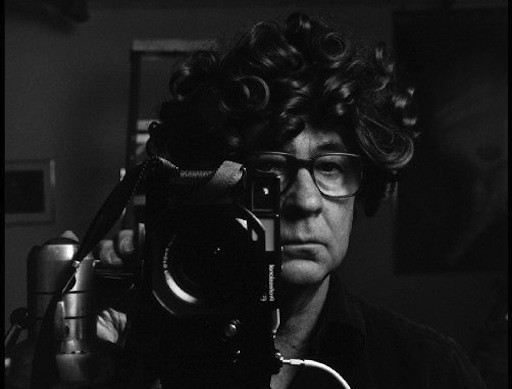The London-born, Brooklyn-based artist Shantell Martin has been garnering an enthusiastic fan base in recent years for her original approach to drawing, which she transforms from what is normally a private studio practice into a multimedia extravaganza. Sometimes working with pens and other times with a computer and a projector, she works in front of a live audience to cover entire rooms—and audience members—and create spectacular, 360-degree worlds out of her whimsical drawings, often while DJ'd music thumps away. A compulsive drawer of smooth, looping lines that morph from one recurring character to another, Martin even covered the bedroom of her Bed-Stuy apartment with a wraparound mural—earning her a glowing spotlight in the New York Times Home & Garden section.
To better understand Martin's approach to her work, Artspace editor-in-chief Andrew M. Goldstein spoke to her about her performative, stream-of-consciousness approach to drawing.
In your work you create massive immersive environments out of drawing, which is usually considered a small-scale, intimate medium. What do you hope to accomplish by blowing it up to such a grand, encompassing scale?
Working at such a big scale for me is like waving a huge flag around in the air. It grabs people's attention, which once I gain can be redirected to my much smaller and more detailed work.
You also produce performance events where you mix DJ'd music, live drawing, and audience participation, having members of the crowd become part of your canvas. What inspired you to make drawing into an interactive experience?
My performance career started in Tokyo where I would live draw under camcorders and project those drawings in real time onto bands, DJs, or dancers creating a very "here now" environment, which lets the audience know this is specially for them—and that even though the performance can be recreated, the exact show can never be repeated. This way of working organically expanded to involve the audience members themselves in the performances. When performance becomes interactive it becomes more relevant, it becomes an experience that can be shared and remembered by the people in that room at that time.
Your drawings are populated by recurring characters, biomorphic shapes, and compositional elements that seem drawn from maps or celestial charts—all drawn in a loose, limpid, and assured line. What kind of story are you telling in these works?
They stories change and grow as I do. Drawing spontaneously means being very driven by what you are feeling and thinking at that time. Now that I have a lot of work to look back on, it's easier to see that some different recurring characters and symbols are people in my life or reflect beliefs that I have.
For example I draw eyes a lot, which represent a character called "Eye." Eye has always existed in the world but she was not always open, let alone aware and responsive. A singular string of events led Eye to the practice of meditation, which helped her become much more accepting of new experiences and more responsive toward the world at large. This new openness is visually manifest in the smooth and regularly shaped flower eyelashes that now frame her in my drawings.
Who are some of the artists who have influenced you most?
Growing up I had no exposure to art and even when I took myself to art school I never went near the library or sought out other artists—I did my own thing. The people who have influenced me in my life the most are those people whose stories are ones of great selfishness, hard work, and victory over different types of struggle.
You sometimes collaborate with your grandmother in London and other members of your family. How does this process work?
My family lives in London, and I see them when I visit once a year or so. By starting to collaborate with them I've created this space for constant contact and communication with them. With my grandmother, for instance, I'll write or call her to see how she is doing and I'll give her instructions for our next piece. Like, "So, Nan, for the next piece can you sew me the words "Lucky in Life" any color, any size." Then she creates the piece and posts it to me. Next I want my nephews to have words shaved into their hair over the course of the next year that collectively will build sentences.
You've recently garnered attention from prominent figures outside of the traditional art world, like Jimmy Kimmel, who made a video with you. To what do you ascribe the broad appeal of your work?
My work doesn't need to be explained—you don't need to know the concept or the process behind it, and it's not pretentious. I draw because I love to draw, and I believe people see that and can relate to the very hands-on humanness of it. I was working for a few days on a wall piece and the plumber who was working on the building came up to me on his last day and told me that he was my new biggest fan and that he really loved my work and wanted to bring his wife to come and see it too. For me that's huge! When the plumber gets it, you know you're doing something right.
What made you want to become an artist?
I'm not sure if it's ever been something I wanted. It's more from a need to just be me.
How has your work changed over the course of your career?
My work has most definitely evolved over the years in medium and also content. Years ago the content was pretty dark, with lots of skulls, unhappy faces, and nooses involved. Over the years the work has become a lot more lighthearted. Also, my line has become more fluid and confident.
How do you get your creative juices flowing?
Music! Normally I start out with some fun loud stuff like Drums of Death or Jahcoozi, and then as I focus more I'll switch over to something more chilled like MNP, a project I do with the cellist Anna Callner.
Where do you look for inspiration?
Inside. I strongly believe that the more we work on being better, nicer, more compassionate and giving people, the more we become inspired by ourselves and small everyday happenings.
What do you hope other people get out of your art?
Mainly I hope that people enjoy it, and that somehow they can relate to it.
What's your favorite thing you've ever made?
I guess that would have to be my bedroom. All of my other artworks exist to me as memories, or past experiences, but by turning my room into an art piece I experience it with fresh eyes everyday. It reminds me of who I am and what I love to do.
What would you be doing if you weren't an artist?
That would be in another lifetime. This time around I'm an artist that's it... no plan B.
What is indispensable in your studio?
Pens!
What do you collect yourself?
From the age of 8 or 9 until into my mid 20s I was an obsessive collector of everything! For real. I collected stamps, foreign coins, posters, plastic bags, paper bags, cigarettes, black t-shirts, sneakers, badges, toy cars, action figures, army badges, tourist postcards, and on and on. I think I was 26 when I decided to start to let everything go, to detach myself from stuff and only have and buy what I needed. Right now I collect experiences—they're pretty cheap and easy to store.
Is there any other art-historical period that you wish you could have lived through?
Hmm... as a young brown woman? Maybe you can suggest a few for me to choose from.
Do you think that it's okay to break the law for the sake of art?
It really depends. If there is a strong message or a need for art, then yes. But if it's just art for art's sake then there are plenty of legal ways to go do that.
Who is your favorite living artist?
Mizuki Shigeru, the creator of GeGeGe no Kitaro, my favorite cartoon character. I think Shigeru is in his 90s now.
If you could get any artist to do your portrait, who would you choose?
I'd choose two and have them collaborate on it: David Shrigley and Kehinde Wiley. That would make for a fun portrait!
Meet the ArtistShantell Martin on Creating Boisterous Universes of Drawing























